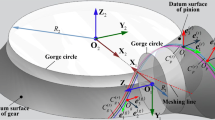Abstract
In multi-axis milling of the aviation complex parts, establishing accurate machining process model is a key technology to realize intelligent processing. In order to obtain accurate machining process model of the aviation complex parts, a method based on morphing technology to construct intermediate process models of multi-axis roughing is proposed. Firstly, the theoretical basis for morphing technology is introduced, and the mathematical model of three hermite transfinite interpolation for morphing technology is established. Then the process constraint which impacts the geometry of the intermediate process model is analyzed in morphing technology. According to the analysis of the process constraint to design the process parameters, and the process parameters with constraints are introduced to the morphing technology to construct the process models. Finally, a validation is conducted on a complex aviation parts. The example shows that the method can able to construct the intermediate process models of complex structure parts for multi-axis rough machining under the condition of controlling the machining allowance, and also can shorten the total processing time of the complex parts, to a certain extent, the processing efficiency is improved.
Similar content being viewed by others
References
J. P. Duncan and S. G. Mair, Sculptured surfaces in engineering and medicine, Cambridge: Cambridge University Press (1983).
R. T. Farouki, The approximation of non-degenerate offset surfaces, Computer Aided Geometric Design, 3 (1) (1986) 15–43.
L. X. Cao, H. Gong and J. Liu, Research on contact problem of surfaces and contact characteristics of offset surfaces, Journal of Dalian University of Technology, 47 (1) (2007) 39.
L. A. Piegl and W. Tiller, Computing offsets of NURBS curves and surfaces, Computer-Aided Design, 31 (2) (1999) 147–156.
T. Saito and T. Takahashi, NC machining with G-buffer method, ACM SIGGRAPH Computer Graphics, 25 (4) (1991) 207–216.
B. K. Choi, D. H. Kim and R. B. Jerard, C-space approach to tool-path generation for die and mould machining, Computer-Aided Design, 29 (9) (1997) 657–669.
B. K. Choi and R. B. Jerard, Sculptured surface machining: Theory and applications, Springer Science & Business Media (2012).
S. Chen, G. R. Yan, Y. Q. Chen and X. X. Zhu, The intelligent machining based on stock-remaining model, Computer Aided Engineering, 9 (3) (2000) 25–32.
D. Douglas and J. Gallier, Topological evolution of surfaces, Graphics Interface, 96 (1996) 194–203.
F. Lazarus and A. Verroust, Three-dimensional metamorphosis: A survey, The Visual Computer, 14 (8) (1998) 373–389.
P. P. Lefebvre and B. Lauwers, 3D morphing for generating intermediate roughing levels in multi-axis machining, Computer-Aided Design and Applications, 2 (1–4) (2005) 115–123.
S. R. Han, New unified machining process planning using morphing technology, University of California, Los Angeles (2011).
S. R. Han and D. C. Yang, Volume interior parameterization for automated unified machining process of freeform surfaces, Frontiers in Computer Education, Springer, Berlin, Heidelberg (2012) 577–584.
B. Huang, A unified approach for integrated computer-aided design and manufacturing, University of California, Los Angeles (2013).
T. Lin, J. W. Lee and E. L. Bohez, A new accurate curvature matching and optimal tool based five-axis machining algorithm, Journal of Mechanical Science and Technology, 23 (10) (2009) 2624.
A. Can and A. Ünüvar, A novel iso-scallop tool-path generation for efficient five-axis machining of free-form surfaces, The International Journal of Advanced Manufacturing Technology, 51 (9–12) (2010) 1083–1098.
A. Can and A. Ünüvar, Five-axis tool path generation for 3D curves created by projection on B-spline surfaces, The International Journal of Advanced Manufacturing Technology, 49 (9–12) (2010) 1047–1057.
J. N. Lee, Tool path generation method for multi-axis machining of helical milling cutter with specific cross-section profile, Journal of Mechanical Science and Technology, 21 (10) (2007) 1644–1650.
H. Jeon, J. Lee and J. Yang, A touch-probe path generation method through similarity analysis between the feature vectors in new and old models, Journal of Mechanical Science and Technology, 30 (10) (2016) 4705–4716.
Author information
Authors and Affiliations
Corresponding author
Additional information
Recommended by Associate Editor Wonkyun Lee
Han Feiyan received her Ph.D. Mechanical Enginering in 2016. She is a Senior Lecturer in Xi’an University of Science and Technology. She has published many papers in different journals in the field of NC manufacturing.
Rights and permissions
About this article
Cite this article
Han, F., Wei, J., Zhang, C. et al. Morphing technology for generating intermediate roughing models in multi-axis machining for complex parts. J Mech Sci Technol 33, 315–322 (2019). https://doi.org/10.1007/s12206-018-1233-2
Received:
Revised:
Accepted:
Published:
Issue Date:
DOI: https://doi.org/10.1007/s12206-018-1233-2



